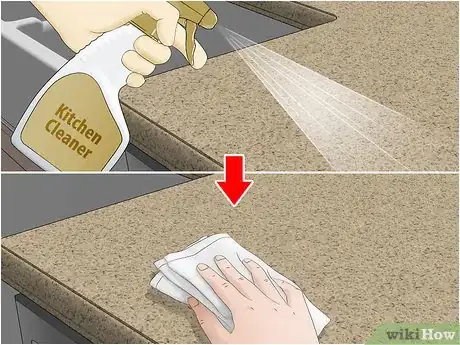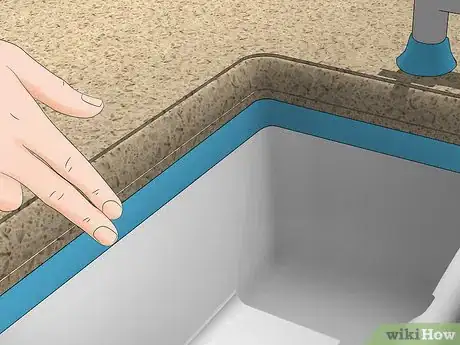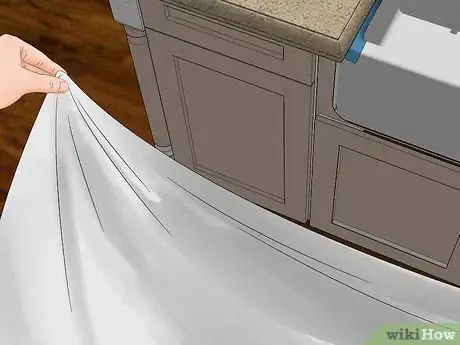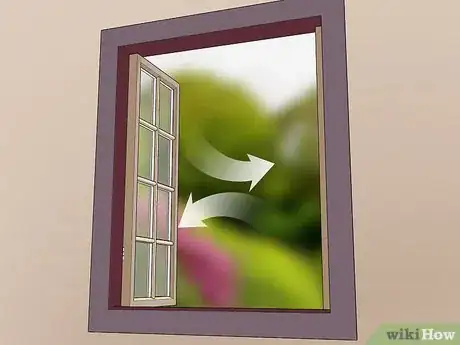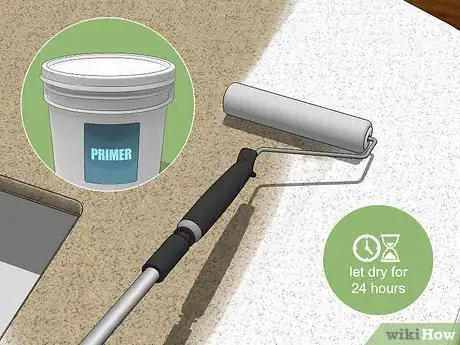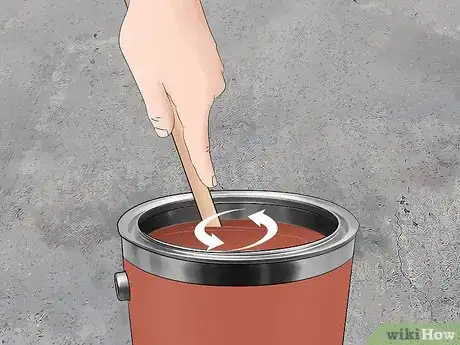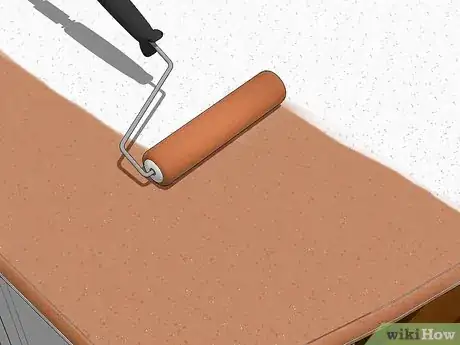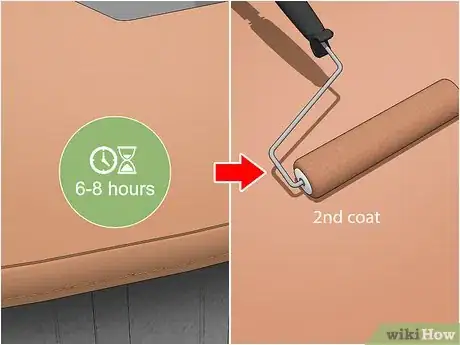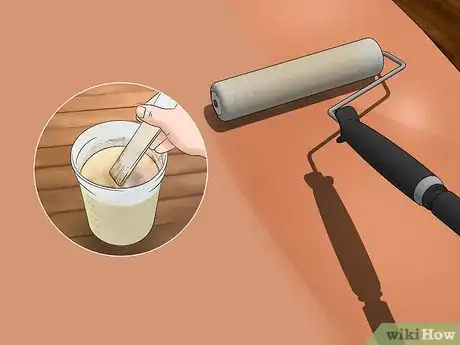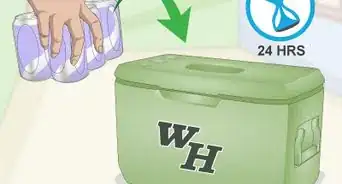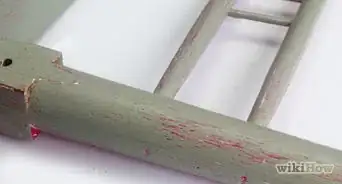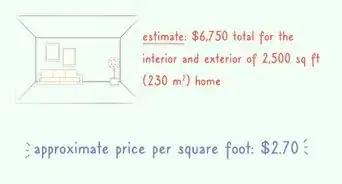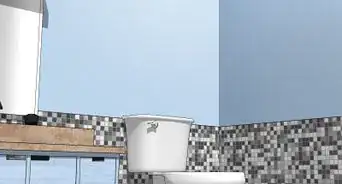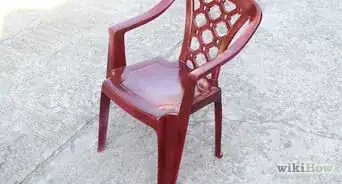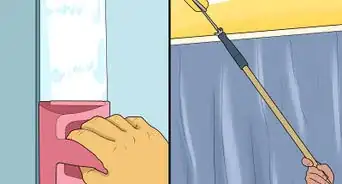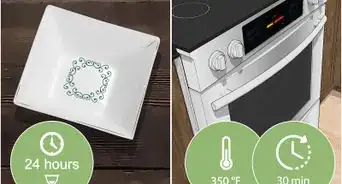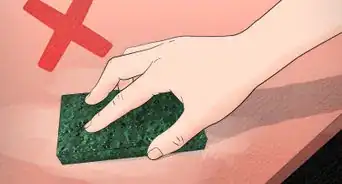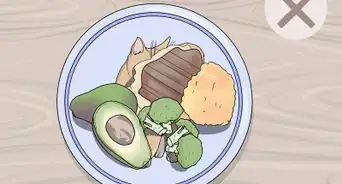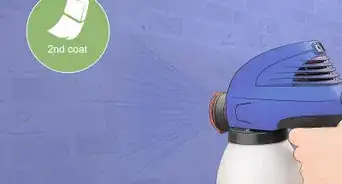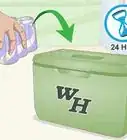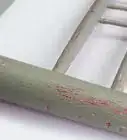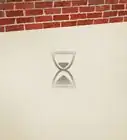This article was co-authored by James Guth. James Guth is the co-owner and founder of Chesapeake Painting Services LLC. With over 20 years of experience, James specializes in exterior and interior painting, drywall, powerwashing, wallpaper, staining, sealing, and carpentry. James holds a BS in Economics and Business Administration with a concentration in Finance from Towson University
This article has been viewed 101,385 times.
If you have a laminate, ceramic, solid-surface, stone, or wood countertop in need of rejuvenation, you may be surprised to learn that you can paint it to make it look nicer. With many high-end countertops costing thousands of dollars to replace, simply painting the countertop is a budget-friendly and surprisingly easy alternative. All you have to do is clean your countertop, apply primer and 2 coats of paint, and then seal it with resin to finish!
Steps
Cleaning and Prepping Your Countertop
-
1Use a cleaning solution to clean your countertop, then let it dry. Kitchen countertops especially can have years of buildup on them, especially if they’re near the stove. Use kitchen cleaner to scrub the countertop free of all dirt, grime, oil, and grease. After you clean it, allow the countertop to completely dry before beginning the painting process.[1]
- You can use a kitchen cleaner, or a combination of dish detergent and water, to clean your countertop. However, don’t use an ammonia-based cleaning solution if your countertop is made of granite or laminate.
- If you want to take extra care in making your countertop ready to paint, you can also sand it with medium-grit sandpaper before you clean it.
- Your countertop probably won’t need more than an hour to completely dry.
-
2Cover any areas that you don’t want painted with painter’s tape. Place the painter’s tape on any trim, walls, or cabinets around your countertops that might have paint dripped on them or be accidentally brushed by your paint roller. Expending the effort on this preparation will save you a lot of time and aggravation on touch-ups and cleanups after you refinish the countertops.[2]
- If you’re painting kitchen countertops, you will especially want to tape off the kitchen sink and the backsplash.
Advertisement -
3Lay down drop cloths to protect your floors. As with any painting job, painting your countertops carries the risk of accidentally dripping or spilling paint on the floor, so laying down drop cloths is very important. Be sure to tape down the drop cloths with painter’s tape to avoid displacing them when you walk on them.
- If you have any old bedsheets that you don’t want anymore, consider repurposing them as convenient (and free) drop cloths!
-
4Make sure the room you’re working in is well ventilated. Open any and all windows in the room and turn on some fans to ensure you have proper ventilation. This will be especially important when you prime the countertop, since most primers (and many paints) have a very strong odor that could linger in your house for days.[3]
- If you have a box fan, place it in a window pointing outside to suck the fumes out of the room as you paint.
- For maximum safety, consider wearing a respirator as well.
Priming, Painting, and Sealing the Countertop
-
1Apply 2 coats of primer to the countertop and allow them to dry. Prepare the countertop with a good quality bonding primer that will improve paint adhesion when you go to apply your actual paint. Allow the primer to dry for 24 hours, then apply a second coat. Let this second coat dry for 24 hours as well before moving on to the next step.[4]
- Because bonding primer tends to be relatively thick, use a foam roller to apply it to make sure you get a smooth application.
- Most primers will need around 24 hours to dry. However, if the manufacturer’s instructions state a different length of time for you to allow the primer to dry, follow these instructions instead.
-
2Mix your paint with a painting stick. It’s very important that you mix the paint before applying it, in order to get it at the right consistency. You should wait to mix your paint until right before you plan to apply it.[5]
- Although all types of countertop can technically be painted, not all paints can be used on each type. Read the label on the paint you have to make sure it works on the material your countertop is made of.
- If you’re unsure which type of paint is right for your countertop material, talk to an employee at a home improvement or paint store to find out which type you need.
-
3Use a paint roller to apply the first layer of paint to the countertop. Pour some of the freshly mixed paint into a paint tray, then dip your roller into the tray to get paint on it. Simply roll the roller over the countertop to apply a thin layer of paint.[6]
- Avoid applying the paint too thickly in any spots; you’ll apply a second coat to the countertop later, so there’s no need to use excess paint here.
-
4Allow the first coat to dry, then apply a second layer of paint. It will probably take at least 6-8 hours for the first coat to completely dry, but to play it safe, wait a full 24 hours before applying the second coat. Paint the second layer with the roller brush the same way you painted the first layer.[7]
- If you’re using a paint kit that is specifically meant to resemble stone or granite, make sure you follow the manufacturer’s instructions for applying the second layer of coat, since it may be more complicated.
-
5Seal the paint with countertop resin to finish the job. Mix your resin according to the manufacturer’s instructions, then use a separate paint roller to spread it evenly across the countertop. The resin will harden shortly after you apply it and will protect your newly painted countertop from chipping or scratching.[8]
- You can buy commercially available resin anywhere painting supplies are sold.
- Keep an eye out for any bubbles that pop up in your resin as it begins hardening. If you spot any bubbles, even them out quickly with your roller. If they’re already hardened, you’ll have to use a blowtorch to reheat the resin and cause the bubbles to pop.
Community Q&A
-
QuestionPolyurethane releases toxic gases. Should this be used on my counter tops?
 Community AnswerWhat are your counter tops made of? If they are made out of butcher block or wood, they make a food grade sealer for this purpose. Check in Lowe's paint department if you live in the USA.
Community AnswerWhat are your counter tops made of? If they are made out of butcher block or wood, they make a food grade sealer for this purpose. Check in Lowe's paint department if you live in the USA. -
QuestionHow long does it usually take coats of paint to dry? Should I work in sections on a long counter top or do it all at once?
 Community AnswerIt depends on the humidity and temperature, inside as well as outside. Check the manufacturer instructions and guide on the can regarding "dry to the touch" and "dry for use," which are two different things. Do the counter top all at once. If you do it in sections, unless there are grout lines or some other definitive line, you run the risk of slightly different coloring in each section, even if it's the same can.
Community AnswerIt depends on the humidity and temperature, inside as well as outside. Check the manufacturer instructions and guide on the can regarding "dry to the touch" and "dry for use," which are two different things. Do the counter top all at once. If you do it in sections, unless there are grout lines or some other definitive line, you run the risk of slightly different coloring in each section, even if it's the same can. -
QuestionDo I have to sand between each coat of water based polyurethane?
 Community AnswerNo, you do not have to sand in between each coat.
Community AnswerNo, you do not have to sand in between each coat.
Things You'll Need
- Kitchen cleaner
- Painter’s tape
- Drop cloth
- Paint
- Painting stick
- Paint roller
- Countertop resin
References
- ↑ https://www.apartmenttherapy.com/how-to-paint-laminate-kitchen-countertops-apartment-therapy-tutorials-217480
- ↑ https://www.bobvila.com/articles/how-to-paint-formica/
- ↑ https://www.bobvila.com/articles/painting-laminate-countertops/
- ↑ https://www.bobvila.com/articles/how-to-paint-formica/
- ↑ https://www.uglyducklinghouse.com/i-painted-my-kitchen-countertops/
- ↑ https://www.bobvila.com/articles/painting-laminate-countertops/
- ↑ https://www.bobvila.com/articles/painting-laminate-countertops/
- ↑ https://www.bobvila.com/articles/painting-laminate-countertops/
About This Article
To paint countertops, start by cleaning the countertops and covering any parts you don't want to paint with tape. Also, open any windows in the room you're working in and set up a box fan so the area is well-ventilated. Next, apply 2 coats of bonding primer to the countertops, letting it dry for 24 hours after each coat. Then, apply 2 coats of paint that's suited for the material of your countertops, and let it dry for 24 hours after each coat. Finally, seal the paint with a coat of countertop resin. To learn how to thoroughly clean your countertops before painting them, read on!
